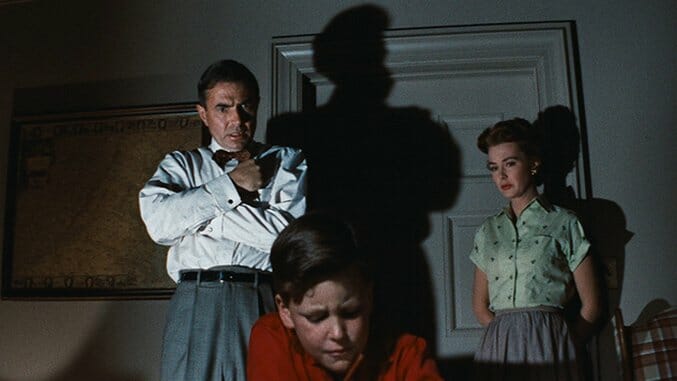Nicholas Ray’s Domestic Monster
In Bigger Than Life, Nicholas Ray explores the shadows among the the dullness of suburban life.

Though the arts have never lacked in memorable freaks—Frankenstein’s monster; Dracula; the slasher Holy Trinity of Michael Myers, Jason Voorhees and Freddy Krueger—the most truly horrifying of monsters are the ones beneath a seemingly normal exterior. It’s why, in cinema, characters like Psycho’s Norman Bates; Mark Lewis, the voyeuristic camera-wielding madman of Peeping Tom; and Carol, the sexually repressed woman at the heart of Repulsion still wield a disturbing grip on our imaginations: Such characters are scary not because they’re unimaginable in the reality we live in, but because they feel like they could be lurking among—or maybe even within—us.
Ed Avery (James Mason), the protagonist of Bigger Than Life, has rarely been considered in the same breath as the aforementioned all-too-human monsters, most likely because Nicholas Ray’s 1956 film isn’t considered a horror movie, per se. It’s better classified as a domestic melodrama, but one with an alarmist medical hook that was fresh at the time: Avery’s increasingly volatile behavior in the film is chalked up to his abuse of cortisone, a drug that was only being introduced then. The film is inspired by a New Yorker article from 1955 by Berton Roueché detailing a case history of a schoolteacher who suffered ill effects as a result of his doctor prescribing him rising dosages of the new drug. In Ray’s adaptation, however, the main character’s cortisone addiction is, to some degree, a MacGuffin for a broader societal malady. Ray’s more interested in the dead end that is suburban middle-class life, a fate to which Ed, empowered by the cortisone, reacts with a fury that is initially liberating, then megalomaniacal, and finally near-deadly.
The cortisone Dr. Norton (Robert Simon) prescribes Ed is technically for polyarteritis nodosa, a rare arterial inflammation that could kill him within a year without treatment. But already, in the film’s opening stages, Ray and screenwriters Cyril Hume and Richard Maibaum suggest that Ed’s ailment is as much metaphorical as physical. He’s overworked, for one thing: Because his teaching job doesn’t pay enough, he’s forced to make ends meet for his family by taking on a second job working the phones at a taxicab company—the latter being something he tries to hide from his wife, Lou (Barbara Rush), covering it under the guise of a lot of extra board meetings at school. Worse than the fatigue, though, is the sense of spiritual emptiness he feels in his current humdrum existence. “Let’s face it: We’re dull,” Ed ruefully says to Lou after a dinner party—just before he collapses from his disease and is forced to go to a hospital. It’s an ennui that threatens to kill him.
Ed’s life at the moment is certainly a far cry from—as is revealed in a brief exchange Ed has with his son, Richie (Christopher Olsen), just before he goes to the hospital—that one moment of glory he had in high school, when he subbed in for a quarterback in an important football game and scored a crucial winning touchdown. But with the cortisone comes rejuvenation…and terror.
In keeping with the film’s metaphorical tenor, Ed’s renewal of energies is more than physical. He not only feels better than he did before, he feels liberated from any sense of social constraints. Soon enough, he’s bringing his family along for the ride, taking Lou and Richie on an impromptu shopping trip to a high-end clothing store, caring not a whit about money even as Lou protests that they can’t really afford the dress he wants to buy her. Even in this sequence, though, foreboding clouds form, as the easy-to-please Lou is forced to try on multiple dresses in order to satisfy his specific taste.
-

-

-

-

-

-

-

-

-

-

-

-

-

-

-

-

-

-

-

-

-

-

-

-

-

-

-

-

-

-

-

-

-

-

-

-

-

-

-

-








































